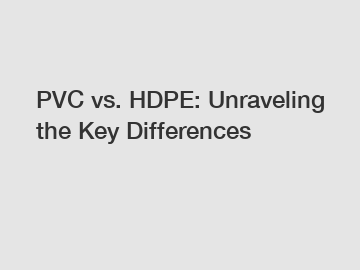Nov. 28, 2023
Rubber & Plastics
When it comes to choosing the right material for your construction or industrial needs, the options can be overwhelming. Two commonly used materials in the industry are PVC (Polyvinyl Chloride) and HDPE (High-Density Polyethylene). While both materials are versatile and offer excellent durability, understanding their differences is crucial. In this article, we will unravel the key dissimilarities between PVC and HDPE, helping you make informed decisions for your projects.
1. PVC: The All-Rounder.
PVC is a synthetic plastic polymer that possesses numerous applications across various industries. Its exceptional durability, resistance to chemicals, and flexibility make it a popular choice for pipes, fittings, and electrical insulation. PVC is known for its high tensile strength and ability to withstand extreme weather conditions, making it ideal for outdoor applications as well. Additionally, PVC is cost-effective and relatively easy to install, making it a favored material for plumbing systems.

2. HDPE: Strength and Versatility.
HDPE, on the other hand, boasts high-density and exceptional strength. It is commonly used for applications that require robust materials such as storage tanks, sewer pipes, and landfill liners. HDPE is known for its resistance to chemical corrosion, making it an ideal choice in industries dealing with harsh chemicals. Its lightweight nature and flexibility also make it suitable for projects that involve transportation or installation in challenging terrains.
3. Chemical Resistance: PVC vs. HDPE.
One of the primary considerations when choosing between PVC and HDPE is the level of chemical resistance required for your project. PVC exhibits superior resistance against acids, alkalis, and other corrosive substances, making it an excellent choice for plumbing and chemical handling applications. HDPE, on the other hand, offers better resistance to saltwater, organic solvents, and even hydrocarbons. Its resistance to cracks and leaks also makes HDPE suitable for applications involving transportation or storage of chemicals.
4. Environmental Impact: Sustainability Matters.
In today's world, sustainability and environmental impact are crucial factors to consider in material selection. PVC has faced criticism due to the toxicity of some components used during its manufacturing process. However, with advancements in technology, manufacturers have developed environmentally friendly versions known as "eco-friendly" or "green" PVC. These alternatives reduce the impact on the environment while maintaining the material's performance. HDPE, on the other hand, is considered more environmentally friendly due to its recyclability and low carbon footprint. The recycling process of HDPE is relatively straightforward, making it a widely accepted choice for sustainable projects.
5. Cost Comparison: Affordability Matters Too.
Budget considerations always play a significant role in any construction or industrial project. PVC is generally a more cost-effective option compared to HDPE. PVC pipes and fittings are readily available and have a lower initial cost. HDPE, on the other hand, tends to be pricier due to its superior strength and durability. While HDPE may involve a higher upfront cost, it offers long-term benefits such as a longer lifespan, reduced maintenance costs, and enhanced resistance to wear and tear. Thus, the choice between PVC and HDPE depends on the specific needs of your project and your budget constraints.
Conclusion:
Selecting the appropriate material for your construction or industrial projects is crucial. Both PVC and HDPE offer admirable qualities, but understanding their differences is essential to ensure the best possible outcome. PVC offers flexibility, cost-effectiveness, and chemical resistance, while HDPE excels in strength, versatility, and environmental impact. Ultimately, the decision between PVC and HDPE should be based on careful evaluation of the specific needs and requirements of your project. So, choose wisely, keeping in mind the unique features and benefits each material offers.
For more hdpe gas, hdpe water service pipe, ISO4427 Standard HDPE Pipes Made In Chinainformation, please contact us. We will provide professional answers.
Previous: Is a bore guide necessary?
If you are interested in sending in a Guest Blogger Submission,welcome to write for us!
All Comments ( 0 )